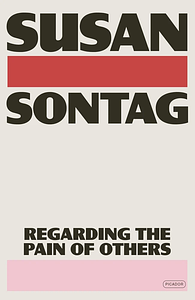You need to sign in or sign up before continuing.
Take a photo of a barcode or cover
dark
emotional
informative
reflective
sad
tense
medium-paced
challenging
informative
reflective
medium-paced
Obviously good; interesting in comparison to [b:Human Rights In Camera|11977962|Human Rights In Camera|Sharon Sliwinski|https://i.gr-assets.com/images/S/compressed.photo.goodreads.com/books/1317085250l/11977962._SY75_.jpg|16941229], where Sliwinski is clearly indebted to Sontag's work (and she does make that clear). The books are remarkably similar, though, and take up some similar case studies (though Sliwinski's adds more historical detail and elaborates on different cases). Sontag is a great writer and a great thinker, and I did appreciate this.
I’m unsure how to distill all thoughts about this — let’s just say my copy is very dog-eared, and sontag’s thoughts on representations of atrocity and what they mean, what they communicate, what they effect, remain all too relevant.
At first I was like yeah yeah uh huh we know and then I realized this was written in 2003
challenging
informative
reflective
fast-paced
challenging
dark
informative
inspiring
reflective
sad
medium-paced
An exploration of war photography and the impact that it has on each person as well as on how society views war. I wonder what Sontag would say in regards to AI and how it can be used to create false images to skew people's view of certain events in the middle of various wars.
It’s fascinating and depressing to see how relevant Sontag’s ruminations on war photography are almost twenty years later, including the conflicts mentioned themselves (just replace mentions of Bosnia and Chechnya with Ukraine).
There’s not one set thesis statement of this work. Instead Sontag examines different ideas surrounding war photography, challenging each of them in turn and allowing the reader to draw their own conclusions. All of her discussions are interesting (is war photography art, is it as real as we presume it to be, is it ethical) but the most fascinating and relevant for me is the question of how repeated exposure to photographs of violence affects the viewer. Sontag mentions the effects of the 24-hour news cycle and its onslaught of atrocities, and while she is careful to point out that this sense of being overwhelmed by news images is hardly new, in the age of social media it feels more relevant than ever.
What impact does seeing violence on a daily basis do to us? Does it numb us to pain, or does it spur us to act? Susan Sontag does not offer a clear conclusion, but does argue that much of our negative responses relates to a sense of helplessness and frustration that we cannot stop the violence depicted in this image. And no matter what, just seeing it is nowhere near close to experiencing it firsthand.
There’s not one set thesis statement of this work. Instead Sontag examines different ideas surrounding war photography, challenging each of them in turn and allowing the reader to draw their own conclusions. All of her discussions are interesting (is war photography art, is it as real as we presume it to be, is it ethical) but the most fascinating and relevant for me is the question of how repeated exposure to photographs of violence affects the viewer. Sontag mentions the effects of the 24-hour news cycle and its onslaught of atrocities, and while she is careful to point out that this sense of being overwhelmed by news images is hardly new, in the age of social media it feels more relevant than ever.
What impact does seeing violence on a daily basis do to us? Does it numb us to pain, or does it spur us to act? Susan Sontag does not offer a clear conclusion, but does argue that much of our negative responses relates to a sense of helplessness and frustration that we cannot stop the violence depicted in this image. And no matter what, just seeing it is nowhere near close to experiencing it firsthand.
challenging
dark
reflective
sad
slow-paced
I would live to know what Sontag would have thought about the proliferation of smart phones, our insatiable desire to shoot video of horrors, sometimes while within the live danger of said horrors instead of perhaps putting our phones away and helping others.
What would she have thought of police body cams, how they capture injustice only to be viewed, consumed yet rarely used to dispense justice.
How would the emotional toll of all that and more of the modern world as I write this be to her as compared the toll this post 9/11 essay took on me nearly a quarter century after it was published.
What would she have thought of police body cams, how they capture injustice only to be viewed, consumed yet rarely used to dispense justice.
How would the emotional toll of all that and more of the modern world as I write this be to her as compared the toll this post 9/11 essay took on me nearly a quarter century after it was published.
dark
informative
reflective
medium-paced






